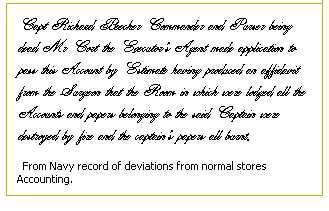 |
 |
Henry Cort Inventor - Creator of puddled iron - Father of iron trade |
 |
 |
| This page is part of a website based on the life and achievements of eighteenth-century inventor Henry Cort. The creator and owner of the site was Eric Alexander who passed away. The site is now hosted by Geneagraphie.com Please contact us with any comments or queries. |
- Homepage
- Life of Henry Cort
- Cort's processes in iron manufacture
- Cort's patents
- Refutation of allegations of conspiracies against Cort
- Adam Jellicoe's death
- Henry Cort's birth
- A navy agent's business
- Early life of John Becher
- Attwick & Burges families
- "Cortship" of second wife
- Thomas Morgan
- Henry Cort's hoops contract
- 1856 Accolade
- Generosity of friends 1789-94
- James Watson
- Illness of Cort's son
- Main sources of information
- Contemporary sources
- Navy sources
- Chancery files
- Publications about Cort
- Assessment of Cort's character
- Images of Henry Cort
Impeach-tranferred to 05
- Parliamentary inquiry 1811-2
- The furore of the 1850s
- Society of Arts
- Cort's first marriage
- Henry Cort's children
- Cort family pensions
- Henry Cort's Hertfordshire property
- 1791 signatories
- Guiana and the Cort-Gladstone connection
- Cort's twilight years
- Memorials to Henry Cort
- Smelting of iron
- Fining before Cort
- Shropshire & Staffordshire ironmasters
- Cumbrians: Wilkinson etc
- Early works at Merthyr Tydfil
- The Crowley business
- London ironmongers
- Scottish iron
- Cort's promotion efforts 1783-6
- Later Merthyr connections
- Puddling after Henry Cort
- Gosport in Cort's day
- Gosport administration
- Gosport worthies
- The Amherst-Porter network
- James Hackman, murderer
- Samuel Marshall
- Samuel Jellicoe's legacy
- Links with Titchfield
- Links with Fareham
- Fact, error and conjecture
- 18th century politics
- Law in the 18th century
- 18th century finance
- Religion and sexual mores
- Calendar change of 1752
- Shelburne, Parry and associates
- John Becher's family
- The Becher-Thackeray lineage
- Thomas Lyttelton: a fantastic narrative
- Eighteenth-century London
- Abolition and the Corts
- The Burges will tangle
- Navy connections
- Navy agent's business
- Cort's clients
- Ships' pursers
- History of Adam Jellicoe
- Dundas & Trotter
- Cort's navy office associates
- Toulmin & other agents
- Sandwich & Middleton
- The Arethusa
- John Becher's war
- Thomas Morgan's war
- The 1782 Jamaica convoy
- Sinking of the Royal George
- Visitors 2006-2009
- Developement of the site 2006-2009
- Daniel Guion and family
- Extremely bad academic work and extremely bad journalism
****************
|
|
A NAVY AGENT'S BUSINESS
The earliest records mentioning Henry Cort by name are found in pension books for Navy widows at the National Archives (ADM22/75 et seq).
Widow's remittances are paid once a year, each year's remittances being recorded in a separate book (sometimes two).
Some widows delegate collection of their remittances to an attorney. One column in the book is reserved for the names of these attorneys.
In October 1757, aged 16 or 17, Cort is cited collecting widows' remittances on behalf of attorney T Bell & Co.
|
Paid to Henry Cort 12 October 1758 for T Bell & Company for son James Administrator. Admiralty record of last remittance for pension of Ann Hackman, carpenter's widow. |
Such records are not suspected by earlier commentators, who rely on London trade directories. They cite 1765 for the start of Cort's career as a navy agent.
You can trace Henry Cort's rise from clerk to agent through PRO half-pay records (ADM25).
Officers, and those in special posts such as surgeons, go on "half pay" (not always half of full pay) between spells of service on ship. Once retired, they are permanently on half pay.
Those on half pay receive remittances twice a year. Each half-pay book covers one six-month period.
 You find that half-pay clients of Thomas Bell move to Thomas Batty by 1761. Full-pay (ADM33) clients are then with "Batty & Cort". Later Cort describes himself as Batty's "copartner" during this period.
You find that half-pay clients of Thomas Bell move to Thomas Batty by 1761. Full-pay (ADM33) clients are then with "Batty & Cort". Later Cort describes himself as Batty's "copartner" during this period.
Though no evidence has been found, it is probable that Cort has paid for his advancement, or someone has paid on his behalf. By 1763 he is sole proprietor of the agency.
This year marks the end of The Seven Years War, when many ships are laid off and officers put on half pay. Half-pay rolls rise rapidly to around 1200.
The number of Cort's half-pay clients rises from 19 to 91. For the next ten years of peace it remains above 70; in some it exceeds 100.
It is apparent from the Navy's pay records that he is collecting pay on behalf of ships' officers and some other ranks.
It is also apparent from chancery files that he is acting as a banker. He keeps accounts for his clients and honours their "bills of exchange" (effectively cheques).
|
Related pages |
The pages on this site are copied from the original site of Eric Alexander (henrycort.net) with his allowance.
Eric passed away abt 2012
If you use/copy information from this site, please include a link to the page where you found the information.
